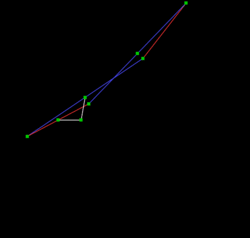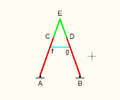Physics:Hart's inversor
From HandWiki


Hart's inversor is one of two mechanisms that provides a perfect straight line motion without sliding guides.[1] They were invented and published by Harry Hart in 1874–5.[1][2]
Hart's first inversor is based on an antiparallelogram. The addition of fixed points and a driving arm make it a 6-bar linkage. It can be used to convert rotary motion to a perfect straight line by fixing a point on one short link and driving a point on another link in a circular arc.[1][3]
Hart's second inversor, also known as Hart's A-frame, is less flexible in its dimensions, but has the useful property that the motion perpendicularly bisects the fixed base points.
Example dimensions
-
- AB = AC = BD = 4
- CE = ED = 2
- Af = Bg = 3
- fC = gD = 1
- fg = 2
-
- AB = Bg = 2
- CE = FD = 6
- CA = AE = 3
- CD = EF = 12
- Cp = pD = Eg = gF = 6
See also
- Straight line mechanism
- Four-bar linkage
- Quadruplane inversor a generalization of Hart's first inversor
References
- ↑ 1.0 1.1 1.2 "True straight-line linkages having a rectlinear translating bar". http://alexandria.tue.nl/repository/freearticles/603890.pdf.
- ↑ Ceccarelli, Marco (23 November 2007). International Symposium on History of Machines and Mechanisms. ISBN 9781402022043. https://books.google.com/books?id=UG0RlFBqwrgC&pg=PA307.
- ↑ "Harts inversor (Has draggable animation)". http://www.cut-the-knot.org/Curriculum/Geometry/HartInversor.shtml.
External links
- bham.ac.uk – Hart's A-frame (draggable animation) 6-bar linkage [|permanent dead link|dead link}}]


